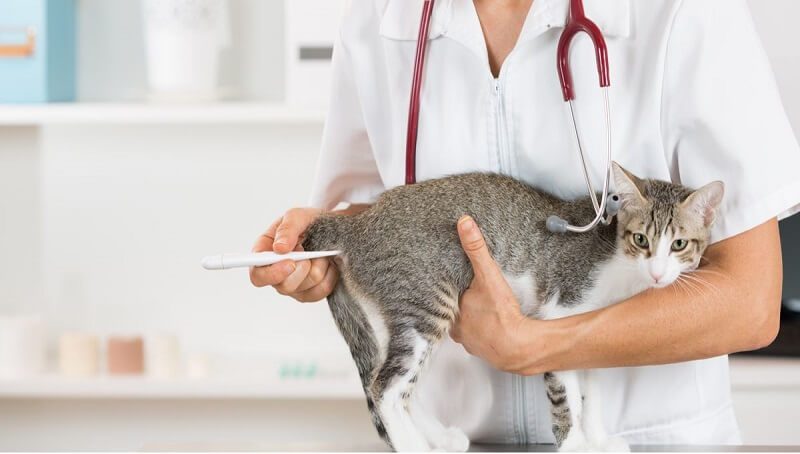The body temperature of a mammal is an important indicator of its health. Read this article to learn more about the temperature of your cat. What is the normal temperature in cats? When is it considered a fever and when is it hypothermia? Below you will find out the most important ranges and symptoms of conditions caused by extreme temperatures.
Normal body temperature of the cat
The term “body temperature” refers to the internal body temperature or the basic body temperature of the cat. This is the temperature of the internal organs.
What is the normal temperature in cats? The body temperature of an adult cat is between 38.0 degrees Celsius and 39.3 degrees Celsius. Some experts also consider 39.0 or 39.2 degrees as the upper limit.
In kittens, the body temperature can be a bit higher: they have a body temperature between 38.0 degrees Celsius and 39.5 degrees Celsius.
At what body temperature do you think your cat has a fever?
If your cat’s temperature is higher than 39.3 degrees Celsius, you can talk about fever.
A value of 41 degrees and above is called a high fever. At 41.6 degrees, the fever becomes dangerous for the life of the feline. The temperature in cats above 43 degrees Celsius is fatal.
When animals have a fever, the thermoregulator center is stimulated by specific substances, normally produced by bacteria (pyrogens), which cause the establishment of a new thermal regulation point, which is above the normal level. That is, the body “thinks” that the normal temperature is higher. From here, the thermoregulator center sets in motion mechanisms to reach and maintain this temperature. Body temperature remains high until the concentration of pyrogens decreases. This decrease causes the body’s thermostat to return to its normal point. During a febrile process, we cannot drastically reduce the temperature. However, we can apply moistened cloths with warm water to the inguinal area, armpits, or abdomen. If the temperature does not drop, you should go to the vet.
You might also like my articles on:
- Home remedies for dogs with fever
- whether a dog’s ears should be warm
- Necessary cat and kitten vaccinations
At the checkup, veterinarians can measure the temperature of cats. Fever in cats is measured rectally for an exact result.
The most important values of body temperature in cats:
- Low temperature < 38 °C
- Normal temperature 38 – 39.3 °C
- Fever 39.3 to 41 °C
- High fever > 41 °C
- Potentially life-threatening fever > 41.6 °C
- Fatal fever > 43 °C
Signs of fever
How can you tell if the cat has a fever? There are a few signs that indicate an increase in body temperature in a cat:
- Reduced appetite
- Drinks less water
- Lack of energy and apathy
- Dry nose, sometimes warm
- Trembles or gasps
But you can’t be completely sure unless you take its temperature with a specialized thermometer.
Not to be confused: Fever and hyperthermia
Fever should not be confused with hyperthermia. Because hyperthermia is an overheating of the body, for example, as a result of a too-warm environment.
Hyperthermia occurs when the body temperature exceeds the upper limit of the optimal temperature. In cats with fever, the temperature generally varies between 39.3ºC and 41ºC. When the temperature is above 41°C, the cause of hyperthermia is generally not febrile and is usually related to heatstroke. The classic case: The animal is left in a closed car for a longer period during summer.
In non-febrile hyperthermia, the thermoregulator center works normally, and the increase in body temperature is due exclusively to the physical and external factors of the body. If your pet suffers from hyperthermia, while going to the vet as soon as possible, you should start to cool it slowly, gently, and progressively, gradually watering it and putting wet clothes on the body. In addition, in the car we can start the air conditioning, but not at a too-low temperature, so we can get safely to the veterinary clinic.
How do you measure the temperature of cats?
 What is the best way to measure temperature in cats? To do this, you need to insert the thermometer rectally. This works best if done by two people: one to hold the cat, the other to take the temperature. A little bit of grease will make things easier.
What is the best way to measure temperature in cats? To do this, you need to insert the thermometer rectally. This works best if done by two people: one to hold the cat, the other to take the temperature. A little bit of grease will make things easier.
Be very careful when you take the temperature, so as not to accidentally injure the animal’s gut. If your cat is too fussy, you should leave this process in the hands of your veterinarian.
Unfortunately, human thermometers are not suitable, as they do not provide reliable results for cats. Tip: Buy a pet thermometer with a bent tip to reduce the risk of injury.
Other less scientific methods, such as palpation of the ears, belly or inguinal area, or muzzle, are not very reliable, especially since our temperature is lower than theirs and under normal conditions, we tend to believe that they are hotter than they are.
Hypothermia in cats
Hypothermia is when the cat’s body temperature has fallen below normal. In cats, hypothermia occurs when the body temperature is below 38 degrees Celsius.
Small and short-haired cat breeds do not cope well with the winter cold. If the kitten has been exposed to cold or cold winds for a long time, hypothermia may occur. The combination of wet fur and cold weather is also dangerous.
Symptoms of hypothermia
The following signs may indicate that your cat has hypothermia:
- The cat trembles.
- Her legs and paws are cold.
- Shock symptoms: rapid pulse, shallow breathing, pale mucous membranes.
If you suspect your cat may have hypothermia, use a thermometer to measure its temperature.
First aid in case of hypothermia
Bring the feline to a warm place as soon as possible when it begins to show symptoms of hypothermia. If the cat is wet, dry it well first.
In a case like this, the animal should be heated with a dryer, thermal blankets, or warm water bottles and taken to a veterinary clinic to be diagnosed and treated as soon as possible, because one of the possible causes of hypothermia is internal bleeding.
Important: Warm the cat little by little. Then take her to the vet as soon as possible. If they experience shock symptoms, give them first aid and contact your current veterinarian or nearest veterinary clinic immediately.




